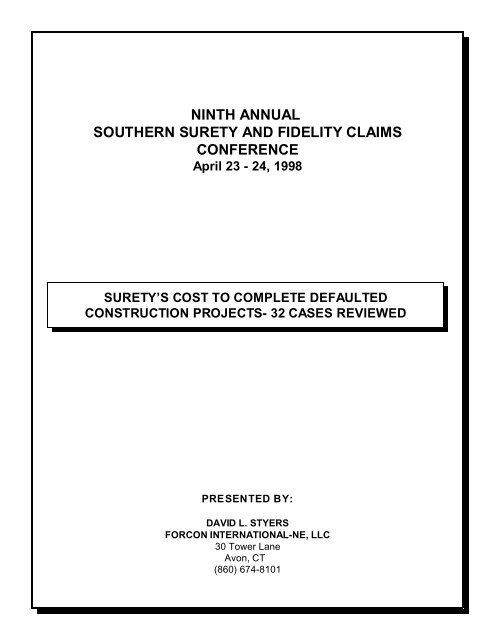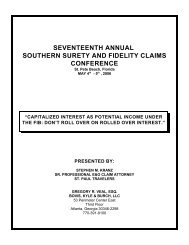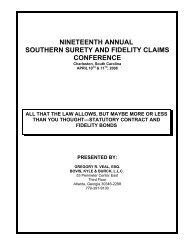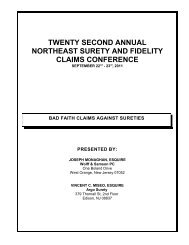surety's costs to complete defaulted construction projects - Forcon ...
surety's costs to complete defaulted construction projects - Forcon ...
surety's costs to complete defaulted construction projects - Forcon ...
Create successful ePaper yourself
Turn your PDF publications into a flip-book with our unique Google optimized e-Paper software.
NINTH ANNUAL<br />
SOUTHERN SURETY AND FIDELITY CLAIMS<br />
CONFERENCE<br />
April 23 - 24, 1998<br />
SURETY’S COST TO COMPLETE DEFAULTED<br />
CONSTRUCTION PROJECTS- 32 CASES REVIEWED<br />
PRESENTED BY:<br />
DAVID L. STYERS<br />
FORCON INTERNATIONAL-NE, LLC<br />
30 Tower Lane<br />
Avon, CT<br />
(860) 674-8101
SURETY’S COST TO COMPLETE DEFAULTED CONSTRUCTION PROJECTS-<br />
32 CASES REVIEWED<br />
WARNING: THE FOLLOWING PRESENTATION CONTAINS ABUNDANT AND EXPLICIT<br />
NUMBERS. VIEWER DISCRETION IS ADVISED AS IT MAY CAUSE DROWSINESS. DO<br />
NOT READ WHILE OPERATING HEAVY MACHINERY.<br />
Although there are many war s<strong>to</strong>ries, there are few, if any, serious statistical studies of surety<br />
completion <strong>costs</strong>. This paper addresses the relationship between the unpaid balance of contract<br />
funds remaining at the time of default and the cost <strong>to</strong> <strong>complete</strong> the <strong>defaulted</strong> contract. Although<br />
the number of cases reviewed is relatively small, the cases were selected randomly and the data<br />
were studied carefully so as <strong>to</strong> yield accurate and reliable conclusions.<br />
This ratio of cost <strong>to</strong> <strong>complete</strong> <strong>to</strong> contract balances will be of interest <strong>to</strong> many. It will be useful <strong>to</strong><br />
surety claims managers in establishing budgets and reserves at a macro level and in setting<br />
performance goals for the surety claims department. In addition this information may be useful<br />
in litigation between the surety and its indemni<strong>to</strong>rs <strong>to</strong> demonstrate that the completion <strong>costs</strong><br />
incurred by the surety were reasonable.<br />
In addition <strong>to</strong> studying the median ratio of the cost <strong>to</strong> <strong>complete</strong> <strong>to</strong> contract balances for all cases<br />
reviewed, this paper will also address how that ratio varies for different types of work, work trades,<br />
project sizes, percentages of completion, and methods of completing. While this sampling is not<br />
large enough <strong>to</strong> yield statistically reliable information at this level of detail, it does point <strong>to</strong> certain<br />
conclusions as well as further areas of study.<br />
DATA COLLECTION<br />
The cases from which data were collected are all cases handled by <strong>Forcon</strong> International as surety<br />
consultants or surety claim managers. All of the available files in <strong>Forcon</strong>’s Florida and<br />
Connecticut offices were considered and reviewed. All of the cases in which <strong>complete</strong> and<br />
reliable data for all of the necessary data elements were found and have been utilized for this<br />
report. Any case in which one or more data elements were missing or could not be verified was<br />
eliminated from the study. Only 32 cases were found that met these requirements. A summary<br />
of the cases utilized in this review follows as Exhibit 1.<br />
This sampling is as close <strong>to</strong> a truly random sampling as can be practically achieved.<br />
Furthermore, there is no reason <strong>to</strong> believe that there is a relationship between our having<br />
<strong>complete</strong> and reliable information on the relevant data elements and any of the fac<strong>to</strong>rs we are<br />
studying. The cases represented are from a diverse group of clients and bond principals. They<br />
represent contracts of all types and sizes. All of the defaults occurred during the last five years<br />
and within the Eastern<br />
2
insert spreadsheet cmpcstex.wk4 (range A1 <strong>to</strong> M42)<br />
3
United States. Unfortunately, the size of the sampling is smaller than necessary for reaching<br />
reliable conclusions about some of the subsets of this data. Nonetheless, the 32 cases chosen<br />
represent a diverse and random sampling of surety bond defaults and contain <strong>complete</strong> and<br />
documented data.<br />
For each of the cases selected, documentation was reviewed and recorded as <strong>to</strong> the trade of the<br />
contrac<strong>to</strong>r, type of work, <strong>to</strong>tal contract amount (adjusted for change orders through completion),<br />
unearned balance of contract funds, earned but unpaid contract funds, retainage, <strong>to</strong>tal cost <strong>to</strong><br />
<strong>complete</strong> the contract work following the principal’s default, and the means by which the work was<br />
<strong>complete</strong>d (relet, finance, obligee completion, etc.) In addition, other fac<strong>to</strong>rs were studied which<br />
appeared <strong>to</strong> affect the completion <strong>costs</strong> such as underbids, defective work, and overpayment by<br />
the Obligee.<br />
RELATIONSHIP BETWEEN CONTRACT BALANCE AND COST TO COMPLETE<br />
The cases studied reflect that the cost <strong>to</strong> <strong>complete</strong> as a percentage of the <strong>to</strong>tal contract balance<br />
varies considerably, but the median ratio is 135%. These ratios range from 48% <strong>to</strong> 733%;<br />
however half of the cases reviewed reflect ratios between 109% and 155%. Most of the data form<br />
a bell curve with a median ratio of 129%, but several exceptional cases extend well beyond.<br />
These data tend <strong>to</strong> confirm the author’s observations from handling over one thousand bond<br />
defaults.<br />
The relationship between the cost <strong>to</strong> <strong>complete</strong> and the <strong>to</strong>tal contract balance was compared with<br />
the ratio of the cost <strong>to</strong> <strong>complete</strong> <strong>to</strong> the unearned contract balance. The <strong>to</strong>tal contract balance<br />
includes earned retainage and earned but unpaid contract funds whereas the unearned contract<br />
balance does not. The median ratio of cost <strong>to</strong> <strong>complete</strong> <strong>to</strong> unearned contract balance is 147%<br />
as compared with 135% for the <strong>to</strong>tal contract balance ratio. Those ratios differ significantly on<br />
cases involving <strong>projects</strong> with a higher percentage of completion, because earned retainage on<br />
those cases is higher. Although there are good reasons <strong>to</strong> study both ratios, the following<br />
discussion will relate <strong>to</strong> the cost <strong>to</strong> <strong>complete</strong> as a percentage of the unearned contract balance<br />
which, for brevity, may be called “the completion premium.” This measure was chosen as more<br />
relevant because it fac<strong>to</strong>red out contract funds which are unrelated <strong>to</strong> the remaining scope of<br />
work.<br />
4
SO, WHY DOES IT COST 40% MORE THAN THE CONTRACT BALANCE TO COMPLETE A DEFAULTED<br />
CONTRACT?<br />
Although not a part of this study it has been this author’s observations over the years that<br />
frequently the bonded principal swears that the cost <strong>to</strong> <strong>complete</strong> his work is equal <strong>to</strong> the contract<br />
balance. This data certainly disprove those promises but do not provide a <strong>complete</strong> explanation<br />
of why. From both the facts surrounding these 32 cases and this author’s experience in handling<br />
or supervising the completion of many bond defaults, one or more of the following fac<strong>to</strong>rs seem<br />
<strong>to</strong> account for the 40% completion premium:<br />
Underbid by Original Contrac<strong>to</strong>r: Many bond defaults arise on <strong>projects</strong> in which the bonded<br />
principal underbid the job; that deficiency in the contract balance is seldom made up before the<br />
contrac<strong>to</strong>r defaults. As a result there are insufficient funds remaining for the surety <strong>to</strong> <strong>complete</strong><br />
the job.<br />
Work Not Performed <strong>to</strong> Specifications: Either because of inexperience, lack of funds, or lack of<br />
concern the original contrac<strong>to</strong>r may not have performed its work properly. The surety will usually<br />
be called upon <strong>to</strong> correct the defective work; often the remedial work is extensive and costly.<br />
Even if the work is performed properly, the mere suspicion of defective work will increase the level<br />
of the Owner’s inspection and the price given by a completing contrac<strong>to</strong>r.<br />
5
The troubled project: Some <strong>construction</strong> <strong>projects</strong> seem <strong>to</strong> <strong>complete</strong> without a single snare and<br />
others seem <strong>to</strong> stumble at every step. The fac<strong>to</strong>rs that create a troubled project are many and<br />
varied, such as poorly developed plans, contrac<strong>to</strong>r underbid, <strong>construction</strong> management which<br />
lacks planning and effective communication, and Owner’s expectations that cannot be achieved<br />
within their budget. Whatever the cause, the contrac<strong>to</strong>r’s <strong>costs</strong> are higher than originally<br />
expected on troubled <strong>projects</strong> and bond defaults certainly occur on such <strong>projects</strong> more frequently.<br />
As a result, the surety’s <strong>costs</strong> in completing this work is higher than the funds remaining.<br />
Front End Loading: Most contrac<strong>to</strong>rs seek <strong>to</strong> bill up front, or at the beginning of the project, their<br />
profit and overhead. As such, after the original contrac<strong>to</strong>r’s default the surety may be compelled<br />
<strong>to</strong> fund the overhead and profit of the completing contrac<strong>to</strong>r.<br />
Labor and Material Cost Escalations: Recently labor and material cost escalations have been<br />
significant. According <strong>to</strong> Engineering News Record, over the past year labor <strong>costs</strong> have<br />
increased about 5% and some material <strong>costs</strong> have increased as much as 20% in the same time.<br />
These cost increases ultimately impact the surety’s completion <strong>costs</strong> especially on long term<br />
<strong>projects</strong> and those in which the principal failed <strong>to</strong> buy out the project early on.<br />
Out of Sequence Work: In the last months leading up <strong>to</strong> the contrac<strong>to</strong>r’s default, lack of financial<br />
resources or lack of concern may result in shortcuts being taken or work being sequenced <strong>to</strong><br />
maximize cash flow rather than efficiency. Completing work out of sequence and completing the<br />
more costly work items left remaining, increases the <strong>costs</strong> <strong>to</strong> <strong>complete</strong> the work.<br />
Remobilization: If a new contrac<strong>to</strong>r is brought in <strong>to</strong> <strong>complete</strong> the work of the <strong>defaulted</strong> contrac<strong>to</strong>r,<br />
the completing contrac<strong>to</strong>r will incur <strong>costs</strong> in “getting up <strong>to</strong> speed” with the work, learning about<br />
the job, developing efficient processes, etc. In addition they will have <strong>costs</strong> in mobilizing<br />
equipment, trailers, or staging, and time spent in preparing re-submittals.<br />
FACTORS INFLUENCING THE EXCEPTIONALLY HIGH AND LOW COMPLETION PREMIUMS<br />
In four of the cases cited here the completion premium was equal <strong>to</strong> or less than 100%. Two of<br />
the lowest cases were surety financing cases in which it appeared that labor and overhead <strong>costs</strong><br />
were borne by other <strong>projects</strong>. In the case in which the completion cost equaled the contract<br />
balance, the contract balance had been adjusted <strong>to</strong> include the insurance proceeds from fire<br />
damage. Since a large portion of the remaining scope of work at the time of the default consisted<br />
of the fire damage repair and the insurance claim settlement was likely influenced by the actual<br />
<strong>costs</strong> incurred <strong>to</strong> <strong>complete</strong> the work it is no surprise that the ultimate cost <strong>to</strong> <strong>complete</strong> the project<br />
equaled the contract balance. In the other case there was a large amount of work performed for<br />
which no payment had been made.<br />
Eight of the cases included in this review (25%) showed completion premiums over 200%. In all<br />
of these there were significant documented overpayments by the obligees. Most of these cases<br />
also reflected documented, defective work and significant (over 20%) underbids.<br />
Overall these extraordinary fac<strong>to</strong>rs overwhelmed the influence of any other fac<strong>to</strong>rs.<br />
6
OTHER FACTORS INFLUENCING THE COMPLETION PREMIUM<br />
This review tracked the relationship between the completion premium and six other aspects of<br />
the bonded contract or completion method:<br />
Type of Work: All of the cases included in this study were categorized in<strong>to</strong> four broad classes of<br />
work: Commercial/governmental, highway and bridge, civil/heavy, and specialty. There were <strong>to</strong>o<br />
few examples of civil and specialty work from which <strong>to</strong> draw any meaningful conclusions. Among<br />
the commercial/governmental work there was great diversity in the completion premiums without<br />
any apparent pattern ranging from 62% <strong>to</strong> 1105%. The median value of 181% may not be<br />
significant. The completion premiums for highway and bridge work are much more consistent<br />
ranging from 77% <strong>to</strong> 154% with 63% of those cases falling in the narrow range of 130% <strong>to</strong> 140%;<br />
the median value is 135%. This relationship may well be significant. It appears that the fact that<br />
most bridge and highway work is awarded on a unit price basis results in fewer cases of large<br />
underbids and overpayments and, therefore, more uniform completion premiums. Also, the well<br />
defined acceptance standards and closer inspection given <strong>to</strong> such work minimizes <strong>construction</strong><br />
defects.<br />
Trade: All of the cases included in this study were categorized in<strong>to</strong> nine broad trade classes:<br />
Civil, electrical, insulation, interior finish, masonry, mechanical, painting, roof and general<br />
contracting. Because of the large number of trades by comparison with the number of cases<br />
studied, no significant relationships could be identified. As a general observation, however, there<br />
is greater diversity in the completion premiums for trade work versus general contracting. The<br />
range of completion premiums for general contracting is 77% <strong>to</strong> 1105% with 67% of the cases<br />
being between 116% and 154%. The median value is 134%. This result is likely explained by the<br />
fact that completion <strong>costs</strong> of general contrac<strong>to</strong>r’s work is often “fixed” by subcontracts and<br />
subcontract <strong>costs</strong> are less likely <strong>to</strong> be affected by the general contrac<strong>to</strong>r’s default.<br />
Contract Amount: This data suggest no discernable relationship between the size of the contract<br />
and the completion premium.<br />
Contract Balance: Generally, the larger the unearned contract balance the smaller the completion<br />
premium. There are several notable exceptions in the data reviewed. The effect of the size of the<br />
contract balance on the completion premium, however, is less significant that the effect of the<br />
percentage of completion discussed below.<br />
Percentage of Completion: Generally, the higher the percentage of completion the higher the<br />
completion premium. Again, however, there are several exceptions in the data. This relationship<br />
can be explained by the fact that learning curve <strong>costs</strong> disproportionately affect those cases which<br />
are nearer <strong>to</strong> completion and that <strong>projects</strong> which go in<strong>to</strong> default in the latter stages often involve<br />
a higher proportion of difficult, out of sequence, warranty, and defective work <strong>to</strong> <strong>complete</strong>.<br />
Completion / Procurement Method: By far the most interesting relationship observed is that<br />
between the method of completion and the completion premium. The cases reviewed included<br />
<strong>projects</strong> <strong>complete</strong>d by the Obligee, those in which the surety financed the principal, contracts<br />
<strong>complete</strong>d by the surety on a time and materials basis, negotiated contract amount, and those<br />
7
elet on a fixed price basis then <strong>complete</strong>d by the surety as a takeover or by tendering the<br />
completing contrac<strong>to</strong>r <strong>to</strong> the obligee.<br />
Only two cases reviewed involved the Surety financing its principal and as noted above it appears<br />
that some of the labor and overhead <strong>costs</strong> in completing those <strong>projects</strong> were borne by another<br />
project, as such the results were unusual and likely not representative. In seven cases the<br />
obligee <strong>complete</strong>d; completion premiums ranged form 100% <strong>to</strong> 1094%. Considering the wide<br />
variance in these results it is difficult <strong>to</strong> reach reliable conclusions, but it does seem clear that,<br />
generally, completion by the bond obligee was significantly more expensive than completion by<br />
the surety. In seventeen cases the surety relet the contacts on a lump sum basis and the results<br />
varied between 116% and 1105% with a median completion premium of 138%. Finally, five of<br />
the <strong>projects</strong> were <strong>complete</strong>d by the surety on a time and materials basis. While this small<br />
sampling cannot be expected <strong>to</strong> yield reliable results it is nonetheless noteworthy that the<br />
completion premiums on these cases ranged from 168% <strong>to</strong> 573% with a median value of 200%.<br />
CONCLUSIONS<br />
Few if any of the observations and conclusions noted here will be surprising <strong>to</strong> the experienced<br />
surety claims person. Indeed this data seem <strong>to</strong> confirm the collective experience of the surety<br />
claims industry. The value of this study lies not in new and insightful conclusions, but in providing<br />
an objective basis and empirical evidence <strong>to</strong> support those conclusions. Although the scope of<br />
this study was limited, the results are nonetheless useful in establishing performance standards<br />
for surety claims departments where macro-level results can be objectively compared <strong>to</strong> these<br />
reference results or in litigation <strong>to</strong> establish proven, realistic completion cost parameters.<br />
However, <strong>to</strong> obtain statistically reliable evidence of completion <strong>costs</strong> for various types of work or<br />
types of procurement, a larger database will be necessary. Perhaps the surety claims industry<br />
will assist in providing additional data from their files <strong>to</strong> assist in that endeavor.<br />
8
David L. Styers<br />
David L. Styers is Vice President of <strong>Forcon</strong> International-NE, LLC in Avon, Connecticut, a surety<br />
and <strong>construction</strong> consulting firm. He received a BA with honors in Philosophy and Political<br />
Science from the University of Virginia in 1979. After working as a property and casualty claims<br />
adjuster for the Farmers Insurance Group in Denver, Colorado, Mr. Styers was a surety claims<br />
supervisor with the Fireman’s Fund Insurance Companies in Nashville and Atlanta and later<br />
Eastern Bond Claim Manager for Transamerica Insurance Group. Most recently, he was Vice<br />
President and the senior surety claims officer for Continental Insurance Company. He is a<br />
member of the Surety Claims Institute, the National Bond Claim Association, and the Friends of<br />
the Fidelity and Surety Law Committee of the American Bar Association TIPS and former Co-<br />
Chair of its Litigation Sub-committee. During his sixteen years in the surety industry Mr. Styers<br />
has been a frequent speaker and contribu<strong>to</strong>r <strong>to</strong> many presentations <strong>to</strong> the National Bond Claim<br />
Association, the Northeast Surety and Fidelity Claims Conference, General Building Contrac<strong>to</strong>rs<br />
of New York State, International Risk Management Institute, The Construction Superconference,<br />
and the ABA National Institute. As co-founder and manager of <strong>Forcon</strong> International-NE, he<br />
manages a surety claim staff, <strong>construction</strong> and engineering consultants, forensic engineers and<br />
accountants, who provide services <strong>to</strong> the insurance and surety industry in the Northeast.






